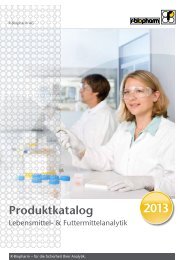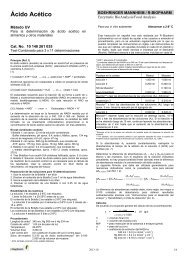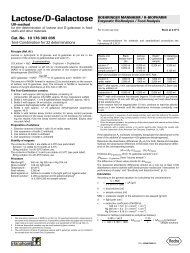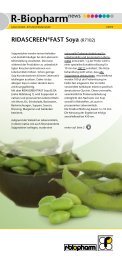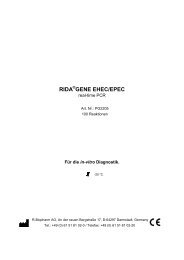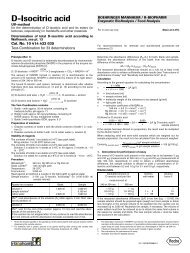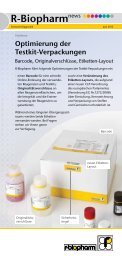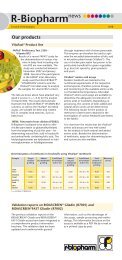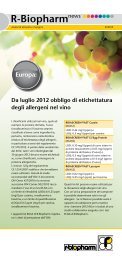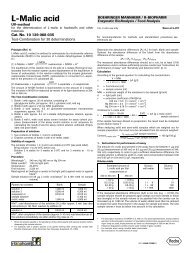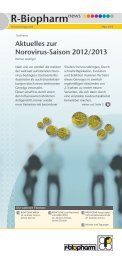Produktinformation - R-Biopharm AG
Produktinformation - R-Biopharm AG
Produktinformation - R-Biopharm AG
Erfolgreiche ePaper selbst erstellen
Machen Sie aus Ihren PDF Publikationen ein blätterbares Flipbook mit unserer einzigartigen Google optimierten e-Paper Software.
RIDASCREEN ® β-Agonists<br />
Enzymimmunoassay zur quantitativen Bestimmung von<br />
β-Agonisten<br />
Enzyme immunoassay for the quantitative analysis of<br />
β-agonists<br />
Art. No.: R1704<br />
In vitro Test<br />
Lagerung bei 2 - 8 °C<br />
Storage at 2 - 8 °C<br />
R-<strong>Biopharm</strong> <strong>AG</strong>, Darmstadt, Germany<br />
Tel.: +49 (0) 61 51 81 02-0 / Telefax: +49 (0) 61 51 81 02-20
Anschrift:<br />
R-<strong>Biopharm</strong> <strong>AG</strong><br />
An der neuen Bergstraße 17<br />
D-64297 Darmstadt<br />
www.r-biopharm.com<br />
Für weitere Fragen stehen Ihnen gerne zur Verfügung:<br />
Telefon:<br />
Zentrale / Auftragsannahme: (0 61 51) 81 02-0<br />
Telefax / E-Mail:<br />
Auftragsannahme: (0 61 51) 81 02-20<br />
orders@r-biopharm.de<br />
Marketing / Vertrieb: (0 61 51) 81 02-40<br />
info@r-biopharm.de<br />
RIDA ® und RIDASCREEN ®<br />
sind eingetragene Warenzeichen der R-<strong>Biopharm</strong> <strong>AG</strong><br />
Hersteller: R-<strong>Biopharm</strong> <strong>AG</strong>, Darmstadt, Deutschland<br />
R-<strong>Biopharm</strong> <strong>AG</strong> ist ISO 9001 zertifiziert.<br />
⎯⎯⎯⎯⎯<br />
RIDA ® and RIDASCREEN ®<br />
are registered trademarks of R-<strong>Biopharm</strong> <strong>AG</strong><br />
Manufacturer: R-<strong>Biopharm</strong> <strong>AG</strong>, Darmstadt, Germany<br />
R-<strong>Biopharm</strong> <strong>AG</strong> is ISO 9001 certified.<br />
2 RIDASCREEN ® β-Agonists 13-10-18
Kurzinformation<br />
RIDASCREEN ® β-Agonists (Art. Nr.: R1704) ist ein kompetitiver Enzymimmunoassay<br />
zur quantitativen Bestimmung von β-Agonisten in Urin, Serum, Fleisch,<br />
Leber, Milch und Futtermitteln.<br />
Alle Reagenzien für die Durchführung des Enzymimmunoassays - inkl. Standards<br />
- sind im Testkit enthalten.<br />
Ein Testkit ist ausreichend für 96 Bestimmungen (einschl. Standardbestimmungen).<br />
Zur Auswertung benötigt man ein Mikrotiterplatten-Photometer.<br />
Probenvorbereitung:<br />
Zeitbedarf:<br />
Nachweisgrenze:<br />
(bezogen auf die<br />
Standardsubstanz)<br />
Urin, Serum (direkt): Zentrifugation, Verdünnung<br />
Urin (SPE): Homogenisierung, Hydrolyse, Zentrifugation,<br />
Filtration, Festphasenextraktion (SPE), Evaporation,<br />
Rekonstitution<br />
Fleisch: Homogenisierung, Zentrifugation, Filtration,<br />
Festphasenextraktion (SPE), Evaporation, Rekonstitution<br />
Leber: Homogenisierung, Extraktion, Zentrifugation,<br />
Evaporation, Rekonstitution<br />
Milch: Extraktion, Zentrifugation, Evaporation,<br />
Rekonstitution<br />
Futtermittel: Homogenisierung, Zentrifugation, Extraktion<br />
Probenvorbereitung (für 10 Proben)<br />
Urin, Serum (direkt)...................................... ca. 30 min<br />
Urin (SPE) ............................. ca. 3 h / über Nacht / 1 h<br />
Fleisch ............................................................... ca. 2 h<br />
Leber ................................................................. ca. 1 h<br />
Milch ............................................................ ca. 45 min<br />
Futtermittel ...................................................... ca. 1,5 h<br />
Testdurchführung (Inkubationszeit) .......................... 1 h<br />
Urin (direkt) ................................................ ca. 200 ppt<br />
Urin (SPE) .................................................. ca. 150 ppt<br />
Serum ......................................................... ca. 900 ppt<br />
Fleisch ........................................................ ca. 100 ppt<br />
Leber .......................................................... ca. 130 ppt<br />
Milch ............................................................. ca. 45 ppt<br />
Futtermittel ................................................ ca. 1000 ppt<br />
RIDASCREEN ® β-Agonists 13-10-18 3
Wiederfindung: Urin (direkt) .................................................... ca. 94 %<br />
(bezogen auf die Urin (SPE) .................................................... ca. 113 %<br />
Standardsubstanz) Serum ........................................................... ca. 102 %<br />
Fleisch ............................................................ ca. 76 %<br />
Leber .............................................................. ca. 89 %<br />
Milch ............................................................... ca. 80 %<br />
Futtermittel ...................................................... ca. 93 %<br />
Spezifität:<br />
Die Spezifität des RIDASCREEN ® β-Agonists Tests<br />
wurde durch Bestimmung der Kreuzreaktivität zu den<br />
entsprechenden Substanzen im Puffersystem ermittelt.<br />
Clenbuterol ................................................... ca. 100 %<br />
Salbutamol ..................................................... ca. 90 %<br />
Cimbuterol ..................................................... ca. 90 %<br />
Brombuterol .................................................... ca. 80 %<br />
Mabuterol ..................................................... ca. 60 %<br />
Terbutaline ...................................................... ca. 45 %<br />
Carbuterol ....................................................... ca. 40 %<br />
Mapenterol ..................................................... ca. 35 %<br />
Cimaterol ....................................................... ca. 20 %<br />
1. Verwendungszweck<br />
RIDASCREEN ® β-Agonists ist ein kompetitiver Enzymimmunoassay zur quantitativen<br />
Bestimmung von β-Agonisten in Urin, Serum, Fleisch, Leber, Milch und<br />
Futtermitteln.<br />
2. Allgemeines<br />
β-Agonisten, wie z.B. Clenbuterol oder Salbutamol, sind synthetische Derivate der<br />
natürlich vorkommenden Catecholamine.<br />
Es ist bekannt, dass β-Agonisten als Leistungssteigerer im Rahmen der<br />
Tierproduktion geeignet sind. Insbesondere kann das Fleisch-/Fettverhältnis von<br />
Masttieren verbessert bzw. das Wachstum beschleunigt werden. Jedoch sind<br />
β-Agonisten als Masthilfsmittel von der Europäischen Union (EU) nicht<br />
zugelassen. β-Agonisten besitzen neben der lipolytischen und anabolen Wirkung<br />
eine relaxierende Wirkung auf die glatte Muskulatur, worauf die therapeutische<br />
Anwendung als Antiasthmatikum und Tokolytikum beruht. Es ist nicht<br />
auszuschließen, dass Rückstände von β-Agonisten nach illegaler Anwendung zu<br />
einer Verbrauchergefährdung führen können. Deshalb ist der Einsatz von β-<br />
Agonisten in der Nahrungsmittelproduktion verboten.<br />
4 RIDASCREEN ® β-Agonists 13-10-18
3. Testprinzip<br />
Grundlage ist die Antigen-Antikörper-Reaktion. Die Vertiefungen der<br />
Mikrotiterstreifen sind mit anti-β-Agonisten-Antikörpern beschichtet. Zugegeben<br />
werden Standards bzw. Probelösung und enzymmarkierte β-Agonisten<br />
(Enzymkonjugat). Freie und enzymmarkierte β-Agonisten konkurrieren um die β-<br />
Agonisten-Antikörperbindungsstellen (kompetitiver Enzymimmunoassay). Nicht<br />
gebundene, enzymmarkierte β-Agonisten werden anschließend in einem<br />
Waschschritt wieder entfernt. Der Nachweis erfolgt durch Zugabe von<br />
Substrat-/Chromogenlösung. Gebundenes Enzymkonjugat wandelt das<br />
Chromogen in ein blaues Endprodukt um. Die Zugabe des Stopp-Reagenzes führt<br />
zu einem Farbumschlag von blau nach gelb. Die Messung erfolgt photometrisch<br />
bei 450 nm; die Extinktion der Lösung ist umgekehrt proportional zur β-Agonisten-<br />
Konzentration in der Probe.<br />
4. Packungsinhalt<br />
Mit den Reagenzien einer Packung können 96 Bestimmungen durchgeführt<br />
werden (einschließlich Standardbestimmungen).<br />
Jedes Testkit enthält:<br />
1 x Mikrotiterplatte mit 96 Kavitäten (12 Streifen à 8 Einzelkavitäten)<br />
beschichtet mit anti-β-Agonisten-Antikörpern<br />
7 x Standardlösungen (je 1 ml; Nullstandard: 2 ml)<br />
0 ppt (Nullstandard), 62,5 ppt, 125 ppt, 250 ppt, 500 ppt, 1000 ppt, 2000 ppt<br />
Clenbuterol in wässriger Lösung<br />
gebrauchsfertig<br />
1 x Konjugat (150 µl) .................................................................. roter Verschluss<br />
Peroxidase-konjugiertes Clenbuterol<br />
100fach Konzentrat<br />
1 x Substrat/Chromogen (12 ml) ........................................... brauner Verschluss<br />
(Substrat-/Chromogenlösung)<br />
1 x Stopp-Reagenz (15 ml) ..................................................... gelber Verschluss<br />
enthält 1 N Schwefelsäure<br />
1 x Puffer (20 ml) .................................................................... weißer Verschluss<br />
Konjugat- und Probenpuffer<br />
4fach Konzentrat<br />
1 x Waschpuffer (30 ml) .......................................................... weißer Verschluss<br />
20fach Konzentrat<br />
RIDASCREEN ® β-Agonists 13-10-18 5
5. Zusätzlich benötigte Reagenzien – erforderliches Zubehör<br />
5.1. Geräte:<br />
− Mikrotiterplatten-Photometer (450 nm)<br />
− Mixer<br />
− Schüttler (Über-Kopf)<br />
− Vortex<br />
− Evaporator<br />
− Säulenständer<br />
− Zentrifuge<br />
− Messpipetten<br />
− variable 20 µl - 200 µl und 200 - 1000 µl Mikropipetten<br />
5. 2. Reagenzien:<br />
Urin (SPE) und Fleisch<br />
− nur Urin: β-Glucuronidase/Arylsulfatase aus Helix pomatia (Merck-Chemicals,<br />
Art. Nr.: 104114); 1:10 (1+9) in demineralisiertem Wasser verdünnen<br />
− 0,1 M HCl<br />
− 1 M Tris-Base (Sigma-Aldrich, Trizma base: Art. Nr.: T1503)<br />
− 100 % Methanol p.a.<br />
− 0,1 M Essigsäure<br />
− 2 % Ammoniumhydroxid: 6,25 ml 32 % Ammoniumhydroxid-Lösung (Merck-<br />
Chemicals, Art. Nr.: 105426) zu 93,75 ml 100 % Methanol p.a. geben<br />
− Filter (0,8 µm)<br />
− RIDA ® C18 column (R-<strong>Biopharm</strong>, Art. Nr.: R2002)<br />
Leber und Milch<br />
− Acetonitril<br />
Futtermittel<br />
− 1 M NaOH<br />
− 1 M HCl<br />
6. Vorsichtsmaßnahmen<br />
Dieser Test ist nur von geschultem Laborpersonal durchzuführen. Die<br />
Gebrauchsanweisung zur Durchführung des Tests ist strikt einzuhalten.<br />
Die Standards enthalten Clenbuterol. Vorsicht ist geboten.<br />
Das Stopp-Reagenz enthält 1 N Schwefelsäure (R36/38, S2-26).<br />
6 RIDASCREEN ® β-Agonists 13-10-18
7. Reagenzien und ihre Lagerung<br />
Die Reagenzien bei 2 - 8 °C lagern. Komponenten des Testkits auf keinen Fall<br />
einfrieren.<br />
Nicht benötigte Kavitäten zusammen mit dem Trockenmittel im Folienbeutel gut<br />
verschlossen aufbewahren und weiterhin bei 2 - 8 °C lagern.<br />
Die Substrat-/Chromogenlösung ist lichtempfindlich, deshalb direkte Lichteinwirkung<br />
vermeiden.<br />
Nach Ablauf des Verfallsdatums (siehe Testkit-Außenetikett unter Expiration)<br />
kann keine Qualitätsgarantie mehr übernommen werden.<br />
Ein Austausch von Einzelreagenzien zwischen Kits verschiedener Chargennummern<br />
ist nicht zulässig.<br />
8. Anzeichen für Reagenzienverfall<br />
− bläuliche Färbung der Substrat-/Chromogenlösung vor Zugabe in die Kavitäten<br />
− Extinktion kleiner 0,8 (E 450 nm < 0,8) für den Nullstandard<br />
9. Probenvorbereitung<br />
Die Proben kühl lagern.<br />
9.1. Urin (direkt)<br />
− zentrifugieren: 5 min / 3000 g / Raumtemperatur (20 - 25 °C)<br />
− den Überstand 1:5 (1+4) mit Probenpuffer in einem Glasgefäß verdünnen<br />
z.B. 50 µl Überstand + 200 µl Probenpuffer und gut mischen<br />
− 25 µl pro Kavität in den Test einsetzen<br />
9.2. Urin (SPE) und Fleisch<br />
− Fleisch zu einer feinen Masse homogenisieren<br />
− 2 ml Urin oder 2 g homogenisiertes Fleisch in ein sauberes Glasgefäß geben<br />
− nur Urin: 20 µl 1:10 verdünnte Helix pomatia β-Glucuronidase/Arylsulfatase<br />
hinzugeben<br />
− 7 ml 0,1 M HCl hinzugeben und vortexen<br />
− nur Urin: für 2 h bei 50 ºC inkubieren<br />
− für 10 min mischen (Überkopf-Schüttler)<br />
− 1 ml 1 M Tris Base hinzugeben<br />
− für 10 min mischen (Überkopf-Schüttler)<br />
− zentrifugieren: 10 min / 2000 g / Raumtemperatur (20 - 25 °C)<br />
− Überstand filtrieren (0,8 µm Filter)<br />
RIDASCREEN ® β-Agonists 13-10-18 7
Das Filtrat mittels RIDA ® C18 column (Art. Nr. R2002) reinigen:<br />
− Säule mit 300 µl 100 % Methanol p.a. waschen<br />
− 300 µl 0,1 M Essigsäure auf die Säule geben<br />
− 3 ml des Filtrats auf die Säule geben (Flussrate: 1 ml/min)<br />
− Probe mit 1 ml 2 %iger Ammoniumhydroxid-Lösung eluieren<br />
− Eluatreste durch Nachdrücken bzw. durch Absaugen aus der Säule gewinnen<br />
(30 s) und Säule für 2 min in einem Luft- oder Stickstoffstrom trocknen<br />
− die eluierte Probe bei 50 °C in einem Luft- oder Stickstoffstrom bis zur Trockene<br />
evaporieren<br />
− den trockenen Rückstand in 0,6 ml Probenpuffer rekonstituieren und mischen<br />
− 25 µl pro Kavität in den Test einsetzen<br />
9.3. Leber<br />
− Leber zu einer feinen Masse homogenisieren<br />
− 2 g der homogenisierten Probe in ein Glasgefäß überführen<br />
− 8 ml Acetonitril hinzugeben und gut mischen (vortexen)<br />
− für 10 min mischen (Überkopf-Schüttler)<br />
− zentrifugieren: 10 min / 2000 g / Raumtemperatur (20 - 25 °C)<br />
− 1 ml des Überstands in ein neues Glasgefäß überführen<br />
− den Überstand bei 50 °C in einem Luft- oder Stickstoffstrom bis zur Trockene<br />
evaporieren<br />
− den trockenen Rückstand in 400 µl Probenpuffer rekonstituieren und vortexen<br />
− 25 µl pro Kavität in den Test einsetzen<br />
9.4. Serum<br />
− zentrifugieren: 5 min / 3000 g / Raumtemperatur (20 - 25 °C)<br />
− den Überstand 1:5 (1+4) in Probenpuffer verdünnen und gut mischen<br />
− 25 µl pro Kavität in den Test einsetzen<br />
9.5. Milch<br />
− 2 ml Milch in ein Glasgefäß überführen<br />
− 8 ml Acetonitril hinzugeben und kräftig mischen (vortexen)<br />
− für 10 min mischen (Überkopf-Schüttler)<br />
− zentrifugieren: 10 min / 2000 g / Raumtemperatur (20 - 25 °C)<br />
− 2 ml des Überstands in ein neues Glasgefäß überführen<br />
− den Überstand bei 50 °C in einem Luft- oder Stickstoffstrom bis zur Trockene<br />
evaporieren<br />
− den trockenen Rückstand in 250 µl Probenpuffer rekonstituieren und vortexen<br />
− 25 µl pro Kavität in den Test einsetzen<br />
8 RIDASCREEN ® β-Agonists 13-10-18
9.5. Futtermittel<br />
− 50 - 100 g der Futtermittelprobe zu einem feinem Pulver vermahlen<br />
− 2 ml 1 M HCl und 18 ml demineralisiertes Wasser zu 2 g des vermahlenen<br />
Futtermittels hinzugeben<br />
− für 3 min vortexen<br />
− für 15 min bei Raumtemperatur (20 - 25 °C) schütteln<br />
− zentrifugieren: 20 min / 2000 g / Raumtemperatur (20 - 25 °C)<br />
− den Überstand in ein neues Gefäß überführen und 1 ml 1 M NaOH hinzugeben<br />
− den pH mit 1 M HCl auf 7,0 - 7,8 einstellen und 1 min vortexen<br />
− zentrifugieren: 20 min / 2000 g / Raumtemperatur (20 - 25 °C)<br />
− 25 µl pro Kavität in den Test einsetzen<br />
10. Testdurchführung<br />
10.1. Testvorbereitungen<br />
Alle Reagenzien vor Gebrauch auf Raumtemperatur (20 - 25 °C) bringen.<br />
Eventuell vorhandene Präzipitate im Konzentrat vor Verdünnung durch Schütteln<br />
bei Raumtemperatur auflösen.<br />
Das enthaltene Pufferkonzentrat wird als Konjugat- und Probenpuffer benötigt.<br />
Das Konzentrat 1:4 (1+3) mit demineralisiertem Wasser verdünnen (z.B. 25 ml<br />
Konzentrat + 75 ml demineralisiertes Wasser). Der endverdünnte Puffer kann bei<br />
2 - 8 °C (35.6 - 46.4 °F) für ca. 4 Wochen gelagert werden.<br />
Das Waschpufferkonzentrat 1:20 (1+19) mit demineralisiertem Wasser<br />
verdünnen (z.B. 2 ml Konzentrat + 38 ml demineralisiertes Wasser, ausreichend<br />
für 4 Mikrotiterstreifen). Der endverdünnte Waschpuffer muss vor Gebrauch frisch<br />
angesetzt werden.<br />
Das Clenbuterol-Enzymkonjugat (Flasche mit rotem Verschluss) liegt als<br />
Konzentrat vor. Da die rekonstituierte Konjugatlösung nur begrenzte Haltbarkeit<br />
aufweist, immer nur so viel Konjugat-Konzentrat mit Konjugatpuffer verdünnen,<br />
wie unmittelbar benötigt wird. Das Konjugat-Konzentrat vor der Entnahme<br />
zentrifugieren (1 min / 1000 g / Raumtemperatur (20 - 25 °C). Um die<br />
gebrauchsfertige Konjugatlösung herzustellen, muss das Konzentrat 1:100 (1+99)<br />
mit endverdünntem Konjugatpuffer verdünnt werden (z.B. 30 µl Konzentrat +<br />
2970 µl endverdünntem Konjugatpuffer, ausreichend für 4 Mikrotiterstreifen).<br />
RIDASCREEN ® β-Agonists 13-10-18 9
10.2. Testdurchführung<br />
Sorgfältiges Waschen ist sehr wichtig. Ein Eintrocknen der Kavitäten zwischen<br />
den Arbeitsschritten vermeiden.<br />
1. So viele Kavitäten in den Halterahmen einsetzen, wie für alle Standards und<br />
Proben in Doppelbestimmung benötigt werden. Die Positionen der Standards<br />
und der Proben protokollieren.<br />
2. Je 25 µl der Standardlösung bzw. der vorbereiteten Proben als Doppelbestimmung<br />
und je 75 µl verdünnte Enzymkonjugat-Lösung in die entsprechenden<br />
Kavitäten pipettieren. Vorsichtig manuell mischen und die Platte<br />
30 min bei Raumtemperatur (20 - 25 °C) im Dunkeln inkubieren.<br />
3. Die Kavitäten durch Ausschlagen der Flüssigkeit leeren und die Restflüssigkeit<br />
durch kräftiges Ausklopfen (dreimal hintereinander) auf saugfähigen<br />
Labortüchern entfernen. Die Kavitäten mit jeweils 300 µl Waschpuffer (siehe<br />
10.1.) waschen. Diesen Vorgang zweimal wiederholen.<br />
4. 100 µl Substrat-/Chromogen in die Kavitäten pipettieren. Vorsichtig manuell<br />
mischen und 30 min bei Raumtemperatur (20 - 25 °C) im Dunkeln<br />
inkubieren.<br />
5. Je 100 µl Stopp-Reagenz in jede Kavität pipettieren und vorsichtig manuell<br />
mischen. Die Extinktion bei 450 nm innerhalb von 30 min nach Zugabe des<br />
Stopp-Reagenzes messen.<br />
10 RIDASCREEN ® β-Agonists 13-10-18
11. Auswertung<br />
Für die Auswertung ist bei R-<strong>Biopharm</strong> eine speziell für die RIDASCREEN ®<br />
Enzymimmunoassays entwickelte Software, die RIDA ® SOFT Win / RIDA ® SOFT<br />
Win.net (Art. Nr. Z9996), erhältlich.<br />
Der Verlauf der Standardkurve kann dem beigefügten Analysenzertifikat entnommen<br />
werden.<br />
Hinweis für die Berechnung ohne Software:<br />
Extinktion Standard (bzw. Probe)<br />
Extinktion Nullstandard<br />
x 100 = % Extinktion<br />
Den Nullstandard somit gleich 100 % setzen und die Extinktionswerte in Prozent<br />
angeben. Die errechneten Werte für die Standards in einem Koordinatensystem<br />
auf halblogarithmischem Millimeterpapier gegen die β-Agonisten-Konzentration<br />
[ng/kg] auftragen.<br />
Um die in den Proben enthaltene tatsächliche β-Agonisten-Konzentration in ng/kg<br />
(ppt) zu erhalten, muss die aus der Eichkurve abgelesene Konzentration noch mit<br />
dem entsprechenden Verdünnungsfaktor multipliziert werden. Beim Arbeiten nach<br />
der angegebenen Vorschrift gilt folgender Verdünnungsfaktor:<br />
Urin (direkt) ........................................................... 5<br />
Urin (SPE) ............................................................. 1<br />
Serum ................................................................... 5<br />
Fleisch ................................................................... 1<br />
Leber ..................................................................... 2<br />
Milch ............................................................... 0,625<br />
Futtermittel .......................................................... 11<br />
Diese Angaben entsprechen dem heutigen Stand unserer Kenntnisse und<br />
sollen über unsere Produkte und deren Anwendungsmöglichkeiten<br />
informieren. Sie haben somit nicht die Bedeutung, bestimmte Eigenschaften<br />
der Produkte oder deren Eignung für einen konkreten Einsatzzweck<br />
zuzusichern. R-<strong>Biopharm</strong> übernimmt keine Gewährleistung, außer für die<br />
standardisierte Qualität der Reagenzien. Defekte Produkte werden ersetzt.<br />
Darüber hinaus gehende Ansprüche für direkte oder indirekte Schäden oder<br />
Kosten aus der Nutzung der Produkte entstehen nicht.<br />
RIDASCREEN ® β-Agonists 13-10-18 11
RIDASCREEN ® β-Agonists<br />
Brief information<br />
RIDASCREEN ® β-Agonists (Art. No.: R1704) is a competitive enzyme immunoassay<br />
for the quantitative analysis of β-agonists in urine, serum, meat, liver, milk<br />
and feed.<br />
All reagents required for the enzyme immunoassay - including standards - are<br />
contained in the test kit.<br />
The test kit is sufficient for 96 determinations (including standards).<br />
A microtiter plate spectrophotometer is required for quantification.<br />
Sample preparation:<br />
Time requirement:<br />
Detection limit:<br />
(corresponding to the<br />
standard substance)<br />
urine, serum (direct): centrifugation, dilution<br />
urine (SPE): homogenization, hydrolysis, centrifugation,<br />
filtration, solid phase extraction (SPE), evaporation,<br />
reconstitution<br />
meat: homogenization, centrifugation, filtration, solid<br />
phase extraction (SPE), evaporation, reconstitution<br />
liver: homogenization, extraction, centrifugation,<br />
evaporation, reconstitution<br />
milk: extraction, centrifugation, evaporation,<br />
reconstitution<br />
feed: homogenization, centrifugation, extraction<br />
sample preparation (for 10 samples)<br />
urine, serum (direct) .............................. approx. 30 min<br />
urine (SPE) ........................approx. 3 h / overnight / 1 h<br />
meat............................................................ approx. 2 h<br />
liver ............................................................. approx. 1 h<br />
milk ....................................................... approx. 45 min<br />
feed ......................................................... approx. 1.5 h<br />
test implementation (incubation time) ....................... 1 h<br />
urine (direct) ........................................ approx. 200 ppt<br />
urine (SPE) .......................................... approx. 150 ppt<br />
serum ................................................... approx. 900 ppt<br />
meat..................................................... approx. 100 ppt<br />
liver ...................................................... approx. 130 ppt<br />
milk ........................................................ approx. 45 ppt<br />
feed ................................................... approx. 1000 ppt<br />
12 RIDASCREEN ® β-Agonists 13-10-18
Recovery rate: urine (direct) ............................................ approx. 94 %<br />
(corresponding to the urine (SPE) ............................................ approx. 113 %<br />
standard substance) serum ..................................................... approx. 102 %<br />
meat......................................................... approx. 76 %<br />
liver .......................................................... approx. 89 %<br />
milk .......................................................... approx. 80 %<br />
feed ......................................................... approx. 93 %<br />
Specificity:<br />
The specificity of the RIDASCREEN ® β-Agonists test<br />
was determined by analyzing the cross-reactivity to<br />
corresponding substances in buffer system.<br />
Clenbuterol ............................................ approx. 100 %<br />
Salbutamol .............................................. approx. 90 %<br />
Cimbuterol .............................................. approx. 90 %<br />
Brombuterol ............................................. approx. 80 %<br />
Mabuterol .............................................. approx. 60 %<br />
Terbutaline ............................................... approx. 45 %<br />
Carbuterol ................................................ approx. 40 %<br />
Mapenterol .............................................. approx. 35 %<br />
Cimaterol ................................................ approx. 20 %<br />
1. Intended use<br />
RIDASCREEN ® β-Agonists is a competitive enzyme immunoassay for the<br />
quantitative analysis of β-Agonists in urine, serum, meat, liver, milk and feed.<br />
2. General<br />
β-Agonists, such as clenbuterol or salbutamol, are synthetic derivatives of the<br />
naturally occurring catecholamines.<br />
It has been known that β-agonists are suitable for use as performance improvers<br />
within the field of livestock production. In particular, the meat/fat ratio in fattened<br />
animals can be improved or the growth may be accelerated. However, such<br />
compounds have not been approved in the EU for use as fattening adjuvants. In<br />
addition to lipolytic and anabolic effects, β-agonists have relaxing effects on nonstriated<br />
musculature. Thus they can be used as antiasthmatic and tocolytic<br />
agents. It is possible that β-agonists residues, after use in illegal practice, may<br />
lead to a risk for consumers. Therefore the use of β-agonists use in food<br />
production was prohibited.<br />
RIDASCREEN ® β-Agonists 13-10-18 13
3. Test principle<br />
The basis of the test is the antigen-antibody reaction. The microtiter wells are<br />
coated with antibodies directed against β-Agonists. β-Agonists standards or<br />
sample solution and β-Agonists enzyme conjugate are added. Free β-Agonists<br />
and β-Agonists enzyme conjugate compete for the β-Agonists antibody binding<br />
sites (competitive enzyme immunoassay). Any unbound enzyme conjugate is then<br />
removed in a washing step. Substrate/chromogen solution is added to the wells,<br />
bound enzyme conjugate converts the chromogen into a blue product. The<br />
addition of the stop solution leads to a color change from blue to yellow. The<br />
measurement is made photometrically at 450 nm. The absorption is inversely<br />
proportional to the β-Agonists concentration in the sample.<br />
4. Reagents provided<br />
Each kit contains sufficient materials for 96 measurements (including standard<br />
analyses).<br />
Each test kit contains:<br />
1 x Microtiter plate with 96 wells (12 strips with 8 removable wells each)<br />
coated with antibodies against β-Agonists<br />
7 x Standard solutions (1 ml each; zero standard: 2 ml)<br />
0 ppt (zero standard), 62.5 ppt, 125 ppt, 250 ppt, 500 ppt, 1000 ppt, 2000 ppt<br />
clenbuterol in aqueous solution<br />
ready-to-use<br />
1 x Conjugate (150 µl) .............................................................................. red cap<br />
peroxidase conjugated clenbuterol<br />
100x concentrate<br />
1 x Substrate/Chromogen (12 ml) ....................................................... brown cap<br />
(Substrate/chromogen solution)<br />
1 x Stop solution (15 ml) ..................................................................... yellow cap<br />
contains 1 N sulfuric acid<br />
1 x Buffer (20ml) ................................................................................... white cap<br />
conjugate and sample buffer<br />
4x concentrate<br />
1 x Washing buffer (30 ml) ................................................................... white cap<br />
20x concentrate<br />
14 RIDASCREEN ® β-Agonists 13-10-18
5. Materials required but not provided<br />
5.1. Equipment:<br />
− microtiter plate spectrophotometer (450 nm)<br />
− mixer<br />
− upside down shaker<br />
− vortex<br />
− evaporator<br />
− column rack stand<br />
− centrifuge<br />
− graduated pipettes<br />
− variable 20 µl - 200 µl and 200 - 1000 µl micropipettes<br />
5.2. Reagents:<br />
Urine (SPE) and meat<br />
− urine only: β-Glucuronidase/Arylsulfatase from Helix pomatia (Merck-<br />
Chemicals, Art. No.: 104114); dilute 1:10 (1+9) in demineralized water<br />
− 0.1 M HCl<br />
− 1 M Tris Base (Sigma-Aldrich, Trizma base, Art. No.: T1503)<br />
− 100 % Methanol p.a.<br />
− 0.1 M acetic acid<br />
− 2 % ammonium hydroxide: add 6.25 ml of 32 % ammonia solution (Merck-<br />
Chemicals, Art. No.: 105426) to 93.75 ml of 100 % methanol p.a.<br />
− filter (0.8 µm)<br />
− RIDA ® C18 column (R-<strong>Biopharm</strong>, Art. No.: R2002)<br />
Liver and milk<br />
− Acetonitrile<br />
Feed<br />
− 1 M NaOH<br />
− 1 M HCl<br />
6. Warnings and precautions for the users<br />
This test should only be carried out by trained laboratory employees. The<br />
instruction for use must be strictly followed.<br />
The standards contain clenbuterol, particular care should be taken.<br />
The stop solution contains 1 N sulfuric acid (R36/38, S2-26).<br />
RIDASCREEN ® β-Agonists 13-10-18 15
7. Storage instructions<br />
Store the kit at 2 - 8 °C (35 - 46 °F). Do not freeze any test kit components.<br />
Return any unused micro wells to their original foil bag, reseal them together with<br />
the desiccant provided and further store at 2 - 8 °C (35 - 46 °F).<br />
The substrate/chromogen is light sensitive, therefore, avoid exposure to direct<br />
light.<br />
No quality guarantee is accepted after the expiration date on the kit label.<br />
Do not interchange individual reagents between kits of different lot numbers.<br />
8. Indication of instability or deterioration of reagents<br />
− any bluish coloration of the substrate/chromogen solution prior to test<br />
implementation<br />
− a value of less than 0.8 absorbance units (A 450 nm < 0.8) for the zero standard<br />
9. Preparation of Samples<br />
The samples should be stored in a cool place.<br />
9.1. Urine (direct)<br />
− centrifuge: 5 min / 3000 g / room temperature (20 - 25 °C / 68 - 77 °F)<br />
− dilute supernatant 1:5 (1+4) in sample buffer in a glass vial<br />
e.g. 50 µl supernatant + 200 µl sample buffer and mix thoroughly<br />
− use 25 µl per well in the assay<br />
9.2. Urine (SPE) and meat<br />
− meat: homogenize completely<br />
− transfer 2 ml of urine or 2 g homogenized meat into a clean glass vial<br />
− urine only: add 20 µl of 1:10 diluted Helix pomatia β-Glucuronidase/<br />
Arylsulfatase<br />
− add 7 ml 0.1 M HCl and vortex<br />
− urine only: incubate for 2 hours at 50 ºC (122 °F)<br />
− mix for 10 min (upside down shaker)<br />
− add 1 ml 1 M Tris Base<br />
− mix for 10 minutes (upside down shaker)<br />
− centrifuge: 10 min / 2000 g / room temperature (20 - 25 °C / 68 - 77 °F)<br />
− filtrate upper layer through a 0.8 µm filter<br />
16 RIDASCREEN ® β-Agonists 13-10-18
The filtrate is purified by means of RIDA ® C18 column (Art. No. R2002):<br />
− rinse the column with 300 µl 100 % methanol p.a.<br />
− apply 300 µl 0.1 M acetic acid to the column<br />
− apply 3 ml of the filtrate to the column (flow 1 ml/min)<br />
− elute sample with 1 ml 2 % ammonium hydroxide solution<br />
− collect all sample by positive pressure or vacuum for 30s and dry column for<br />
2 min by floating it with air or nitrogen<br />
− evaporate the eluted sample to dryness under a mild nitrogen or air flow at<br />
50 °C (122 °F)<br />
− dissolve the dried residue in 0.6 ml sample buffer and mix<br />
− use 25 µl per well in the assay<br />
9.3. Liver<br />
− homogenize liver completely<br />
− transfer 2 g of homogenized liver in a clean glass vial<br />
− add 8 ml of acetonitril and mix vigorously (vortex)<br />
− mix for 10 min (upside down shaker)<br />
− centrifuge: 10 min / 2000 g / room temperature (20 - 25 °C / 68 - 77 °F)<br />
− transfer 1 ml of the supernatant into a glass vial<br />
− evaporated to dryness under a mild nitrogen or air flow at 50 °C (122 °F)<br />
− dissolve the dried residue in 400 µl sample buffer and vortex<br />
− use 25 µl per well in the assay<br />
9.4. Serum<br />
− centrifuge: 5 min / 3000 g / room temperature (20 - 25 °C / 68 - 77 °F)<br />
− dilute supernatant 1:5 (1+4) in sample buffer and mix thoroughly<br />
− use 25 µl per well in the assay<br />
9.5. Milk<br />
− transfer 2 ml of milk into a glass vial<br />
− add 8 ml of acetonitrile and mix vigorously (vortex)<br />
− mix for 10 min (upside down shaker)<br />
− centrifuge: 10 min / 2000 g / room temperature (20 - 25 °C / 68 - 77 °F)<br />
− transfer 2 ml of the supernatant into a glass vial<br />
− evaporate to dryness under a mild nitrogen or air flow at 50 °C (122 °F)<br />
− dissolve the dried residue in 250 µl sample buffer and vortex<br />
− use 25 µl per well in the assay<br />
RIDASCREEN ® β-Agonists 13-10-18 17
9.6. Feed<br />
− grind sample (approx. 50 - 100 g) into a fine powder<br />
− add 2 ml of 1 M HCl and 18 ml of demineralized water to 2 g of the ground feed<br />
− vortex for 3 min<br />
− shake for 15 min at room temperature (20 - 25 °C / 68 - 77 °F)<br />
− centrifuge: 20 min / 2000 g / room temperature (20 - 25 °C / 68 - 77 °F)<br />
− transfer supernatant into a new vial and add 1 ml of 1 M NaOH<br />
− adjust pH to 7.0 - 7.8 with 1 M HCl and vortex for 1 min<br />
− centrifuge: 20 min / 2000 g / room temperature (20 - 25 °C / 68 - 77 °F)<br />
− use 25 µl per well in the assay<br />
10. Test implementation<br />
10.1. Preliminary comments<br />
Bring all reagents to room temperature (20 - 25 °C / 68 - 77 °F) before use.<br />
Eventually occurring precipitates in the concentrates have to be dissolved by<br />
shaking at room temperature before dilution.<br />
Please use the contained buffer concentrate as conjugate and sample buffer.<br />
Dilute buffer 1:4 (1+3) with demineralized water (e.g. 25 ml concentrate + 75 ml<br />
demineralized water). The diluted buffer can be stored at 2 - 8 °C (35.6 - 46.4 °F)<br />
for 4 weeks.<br />
Dilute washing buffer concentrate 1:20 (1+19) with demineralized water (e.g. 2<br />
ml concentrate + 38 ml demineralized water, sufficient for 4 microtiter strips).<br />
Washing buffer must be prepared freshly before use.<br />
The clenbuterol enzyme conjugate (bottle with red cap) is provided as a<br />
concentrate. Since the diluted enzyme conjugate solution has a limited stability,<br />
only the amount which actually is needed should be reconstituted. Centrifuge the<br />
conjugate in the vial shortly (1 min / 1000 g / room temperature (20 - 25 °C /<br />
68 - 77 °F). For reconstitution, the concentrate is diluted 1:100 (1+99) in ready-touse<br />
conjugate buffer (e.g. 30 µl conjugate concentrate + 2970 µl ready-to-use<br />
conjugate buffer, sufficient for 4 microtiter strips).<br />
18 RIDASCREEN ® β-Agonists 13-10-18
10.2. Test procedure<br />
Carefully follow the recommended washing procedure. Do not allow microwells to<br />
dry between working steps.<br />
1. Insert a sufficient number of wells into the microwell holder for all standards<br />
and samples to be run in duplicate. Record standard and sample positions.<br />
2. Add 25 µl of standard or prepared sample to separate duplicate wells and<br />
add 75 µl of diluted enzyme conjugate solution of each well. Mix gently by<br />
shaking the plate manually and incubate for 30 min at room temperature<br />
(20 - 25 °C / 68 - 77 °F) in the dark.<br />
3. Pour the liquid out of the wells and tap the microwell holder upside down<br />
vigorously (three times in a row) against absorbent paper to ensure complete<br />
removal of liquid from the wells. Fill all wells with 300 µl of washing buffer<br />
(see 10.1.) and pour out the liquid again. Repeat two more times.<br />
4. Add 100 µl of substrate/chromogen to each well. Mix gently by shaking the<br />
plate manually and incubate for 30 min at room temperature (20 - 25 °C /<br />
68 - 77 °F) in the dark.<br />
5. Add 100 µl of the stop solution to each well. Mix gently by shaking the plate<br />
manually and measure the absorbance at 450 nm. Read within 30 min after<br />
addition of stop solution.<br />
RIDASCREEN ® β-Agonists 13-10-18 19
11. Results<br />
A special software, the RIDA ® SOFT Win / RIDA ® SOFT Win.net (Art. No. Z9996),<br />
is available to evaluate the RIDASCREEN ® enzyme immunoassays.<br />
The course of the standard curve is shown in the Quality Assurance Certificate<br />
enclosed in the test kit.<br />
Remark for the calculation without software:<br />
absorbance standard (or sample)<br />
absorbance zero standard<br />
x 100 = % absorbance<br />
The zero standard is thus made equal to 100 % and the absorbance values are<br />
quoted in percentages. The values calculated for the standards are entered in a<br />
system of coordinates on semilogarithmic graph paper against the β-agonists<br />
concentration [ng/kg].<br />
In order to obtain the β-agonists concentration in ng/kg (ppt) actually contained in<br />
a sample, the concentration read from the calibration curve must be further multiplied<br />
by the corresponding dilution factor. When working in accordance with the<br />
regulation stated, the dilution factor is as follows:<br />
urine (direct) .......................................................... 5<br />
urine (SPE) ............................................................ 1<br />
serum .................................................................... 5<br />
meat ...................................................................... 1<br />
liver ....................................................................... 2<br />
milk ................................................................. 0.625<br />
feed ..................................................................... 11<br />
R-<strong>Biopharm</strong> makes no warranty of any kind, either expressed or implied,<br />
except that the materials from which its products are made are of standard<br />
quality. If any materials are defective, R-<strong>Biopharm</strong> will provide a replacement<br />
product. There is no warranty of merchantability of this product, or of the<br />
fitness of the product for any purpose. R-<strong>Biopharm</strong> shall not be liable for any<br />
damages, including special or consequential damage, or expense arising<br />
directly or indirectly from the use of this product.<br />
20 RIDASCREEN ® β-Agonists 13-10-18



